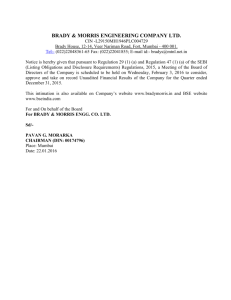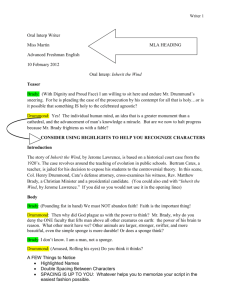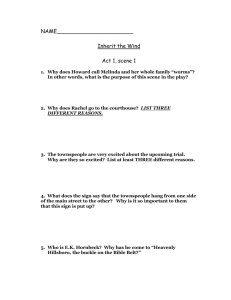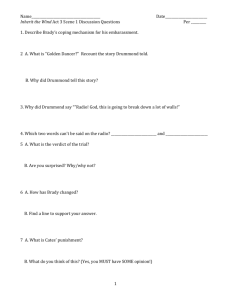The Wonderful Country
advertisement
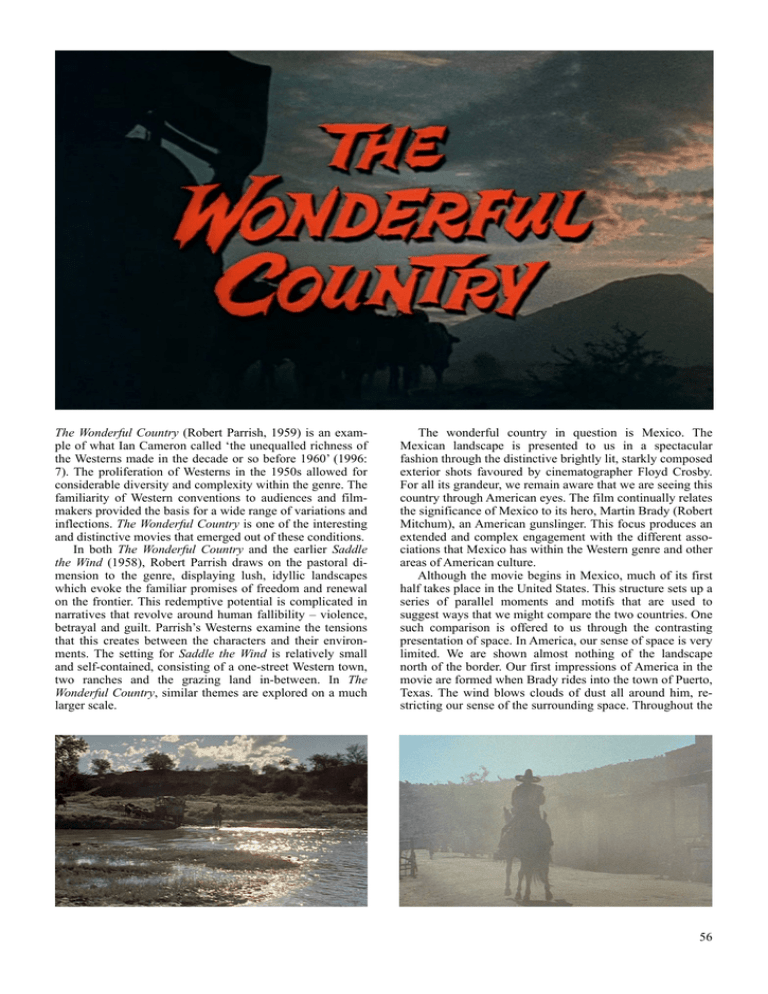
The Wonderful Country (Robert Parrish, 1959) is an example of what Ian Cameron called ‘the unequalled richness of the Westerns made in the decade or so before 1960’ (1996: 7). The proliferation of Westerns in the 1950s allowed for considerable diversity and complexity within the genre. The familiarity of Western conventions to audiences and filmmakers provided the basis for a wide range of variations and inflections. The Wonderful Country is one of the interesting and distinctive movies that emerged out of these conditions. In both The Wonderful Country and the earlier Saddle the Wind (1958), Robert Parrish draws on the pastoral dimension to the genre, displaying lush, idyllic landscapes which evoke the familiar promises of freedom and renewal on the frontier. This redemptive potential is complicated in narratives that revolve around human fallibility – violence, betrayal and guilt. Parrish’s Westerns examine the tensions that this creates between the characters and their environments. The setting for Saddle the Wind is relatively small and self-contained, consisting of a one-street Western town, two ranches and the grazing land in-between. In The Wonderful Country, similar themes are explored on a much larger scale. The wonderful country in question is Mexico. The Mexican landscape is presented to us in a spectacular fashion through the distinctive brightly lit, starkly composed exterior shots favoured by cinematographer Floyd Crosby. For all its grandeur, we remain aware that we are seeing this country through American eyes. The film continually relates the significance of Mexico to its hero, Martin Brady (Robert Mitchum), an American gunslinger. This focus produces an extended and complex engagement with the different associations that Mexico has within the Western genre and other areas of American culture. Although the movie begins in Mexico, much of its first half takes place in the United States. This structure sets up a series of parallel moments and motifs that are used to suggest ways that we might compare the two countries. One such comparison is offered to us through the contrasting presentation of space. In America, our sense of space is very limited. We are shown almost nothing of the landscape north of the border. Our first impressions of America in the movie are formed when Brady rides into the town of Puerto, Texas. The wind blows clouds of dust all around him, restricting our sense of the surrounding space. Throughout the 56 part of the film set in and around Puerto, the spaces we see in exterior shots are broken up and obstructed by shop signs, branches, archways and other such features. We are not shown anything comparable to the vast, open landscapes that we see in Mexico. The film’s representation of Mexico as a place of large, empty spaces extends to its interiors. Towards the end of the movie, Captain Rucker (Albert Dekker) of the Texas Rangers, Captain Stoker (Joe Haworth) of the US Army and the Mexican General Marcos de Castro (Victor Mendoza) discuss Brady in a cavernous room in the fort at El Pulpito. Most of the scene is made up of alternating medium shots of the characters and tightly framed long shots of the whole group. However, we are continually reminded of the size of the surrounding space by the echoing of the characters’ voices. The spatial contrast between the two countries is also emphasised through a number of instances of repetition and doubling. We are often presented with American and Mexican versions of the same situation, staging or setup. One example of such a pairing is the conversations that Martin Brady has on each side of the border with an authority figure on a veranda. The first of these is in Puerto with Captain Rucker, where the Captain talks to Brady about his violent past and invites him to join the Texas Rangers. In the second conversation, Brady reports to General Castro in Mexico (Brady is employed by the Castro family as a hired gun), where he is quizzed on the situation in America. In both scenes, the space of the veranda is established in the same way. Our view is down the length of it, as if it were a corridor, with the inside to the left of the frame and the outside to the right. In both cases, Brady walks along the veranda from foreground to background, strengthening the correspondence through parallel movement. These similarities are used to draw our attention to the contrasting presentations of space and scale. The space of the American veranda is small and tight, with a low camera angle accentuating the ceiling. The General’s veranda is another huge Mexican space. Its depth is emphasised by the tiny figure of Brady when he first appears in the background and the time it takes him to reach the General in the foreground. The different senses of space that characterise each country are associated with different levels of apparent freedom for Brady. He is able to ride freely through the Mexican landscape, whereas he falls off his horse when he arrives in America and spends most of his time there recovering from a broken leg. Although the freedom of Mexico is expressed through some attractive imagery, it is not offered to us as unambiguously positive. In keeping with Parrish’s approach to the Western, the beauty of Mexico is offset by its association with flawed humanity. This is achieved by drawing on the common association of Mexico with escape. Often in Hollywood movies, Mexico is where fugitive Americans go to get beyond the reach of the law. Brady’s Mexican freedom is presented in explicit opposition to concerns of morality and responsibility. We learn that he 57 first ended up in Mexico when he fled America after killing the man who killed his father. The same pattern recurs in the movie. Barton (Chuck Roberson) kills Brady’s friend Ludwig ‘Chico’ Sterner (Max Slaten) with a broken bottle, and then draws his gun on Brady, who shoots him dead. Brady is unable to face the consequences of his actions and escapes once again to Mexico. Brady’s freedom there becomes associated with the avoidance of responsibility. In addition, although he may be relatively free from moral and legal constraints in Mexico, Brady is still subject to other kinds of authority. Discussing the Mexican sequences in Kill Bill Vol. 2 (Quentin Tarantino, 2004), Edward Gallafent refers to ‘a familiar literary and filmic trope’ involving ‘the implication that over the border sexual activity is less regulated by law but more often subject to the control exercised by a father figure’ (2006: 116). This description can be applied to other areas as well as sex. Films set in Mexico often feature male authority figures – Mapache (Emilio Fernandez) in The Wild Bunch (Sam Peckinpah, 1969) is a good example – whose power is portrayed as almost feudal in nature. This is the type of power to which Martin Brady must submit in exchange for escaping the restrictions of America. His freedom from the law is bought at the cost of his individual autonomy and agency. In Mexico, he is effectively the property of the Castro family. In his conversations with General Marcos and Don Cipriano de Castro (Pedro Armendariz), Brady is continually commanded, insulted, interrupted and corrected. When Brady announces his intention to stop working for the Castros, Don Cipriano characterises their relationship in terms of indentured servitude and claims that, under Mexican law, he has the right to have Brady killed. The Don’s reaction here can be connected to another of the comparisons that the film suggests between America and Mexico: the different attitudes to violence in each country. In America, violence is shown to be evaluated according to moral, legal and social standards. Captain Rucker excuses Brady’s shooting of his father’s killer, D.M. Follett, in these terms: ‘The general opinion was that you did the community a service. Follett was wanted by every sheriff between here and Montana.’ Later, in Mexico, Rucker tells Brady that there are witnesses who say that Barton drew first, and so that killing can also be justified in American terms (and terms that will be familiar to an audience accustomed to watching Westerns). Rucker’s interest in recruiting Brady for the Texas Rangers comes from a desire to harness his violence to a socially sanctioned purpose. This view of violence is not understood in Mexico, where violence is treated as a commodity, paid for by the wealthy and used to demonstrate and consolidate their power. The difference between these two perspectives on violence is emphasised by another pair of parallel moments in the movie. In both America and Mexico, Brady is asked about the political and military powers on the other side of the border. In Texas, Major Colton (Gary Merrill) wants to know who ‘the properly constituted authorities’ are in Mexico so that he can approach them about helping him fight the Apaches. Brady’s explanation makes it clear to us, if not to the Major, that ‘properly constituted authorities’ is not quite appropriate as a description of the way things are run south of the Rio Grande. Similarly, General Marcos can only understand America in Mexican terms. Despite Brady’s attempts to correct him, the General refers to the Texas Rangers as ‘assassins’, and demands to know who ‘buys’ them. The American attitude to violence, as expressed by Colton, is bureaucratic; the Mexican perspective is mercenary. Neither alternative is offered to us as entirely satisfactory. Colton is shown to be dogmatic and ineffectual in the battlefield, whilst the Castros are treacherous, power-hungry despots. Most of the American characters in the film are more relaxed than Major Colton, who is so earnest and upright that he is compared to a ‘flagpole’. Nonetheless, the Major represents an extreme version of a quality that is more broadly associated with the American side: repression. This is juxtaposed with the stereotypical passion and intensity that we see in Mexico. Kim Newman argues that The Wonderful Country ‘furthers the Western’s use of the Latin country as either the United States’ unconscious or its libido’ (1996: 312). The contrast is particularly explicit in the two scenes depicting celebrations. At the American party, the seated guests sing along to ‘Where Did You Get That Hat?’ without much enthusiasm and couples shuffle awkwardly around an overcrowded dance floor. Major Colton dourly insists that his wife, Helen (Julie London) should join him for the socially expected first dance, even if she does not want to. The overall impression is of a tense and joyless public occasion. The Mexican fiesta that we see later in the movie is presented very differently, as an explosion of chaotic intensity. The visual style of the rest of the movie is temporarily taken over by images that reflect the more expressionistic inclinations of Mexican cinematographer Alex Phillips, who shares the credit with Crosby. Shots of revellers and dancers, filmed with a hand-held camera at close 58 quarters and awkward angles, as if from within the crowd, are combined with shots of fireworks and grotesque carnival masks against a cacophony of music and noise. Dissolves and superimpositions give the sequence a hallucinatory quality. Nothing this vivid or strange could take place in the America that we see in the movie. In America, such intensity is held much more strictly in check. The film explores some of the tensions involved in this through the illicit relationship between Martin Brady and Helen Colton. The basis for this relationship is first established in a scene in the Coltons’ parlour at the fort in Texas, where Brady is waiting to see the Major. Brady and Mrs. Colton bond over their shared experiences of a lonely, rootless existence, his as a hired pistolero and hers as an army wife. Once again, this scene is paired with another one in Mexico. The developing emotional connection is clear enough in the American parlour scene, but it remains a subtext. Mrs. Colton spends much of the conversation with her back to Brady. When she looks at him or smiles, she does so only briefly before turning away or looking down (this gesture is lent particular weight by the length of Julie London’s eyelashes). The atmosphere is one of claustrophobic domesticity. Mrs. Colton is wearing an apron and the room is cluttered and disorganised because the Coltons have not finished moving in. In the Mexican parlour scene, which takes place after we see the fiesta, everything is more overt and explicit. The two characters are more candid about their attraction to one another, and about their own flaws and transgressions. Brady talks about killing ‘for money’ and Mrs. Colton admits to previous extramarital affairs. The mise-en-scène reflects the higher level of openness and intensity – the décor is lavish and Mrs. Colton is wearing a bright blue dress. At the end of the scene they kiss and we dissolve into the next sequence. Their affair is implicitly consummated, something which, by the logic that the movie establishes, could happen only in Mexico. Much of the sense that we get in the film of intense emotion and its careful restraint comes from Julie London’s performance. London is perhaps better known as a singer, but her ability to control and inflect her voice was also a valuable skill for her as an actress. The tone of Helen Colton’s speaking voice is warm and alluring, but her diction is precise and deliberate. Along with London’s strikingly large and expressive eyes, these qualities allow her to convey a sense of controlled intensity. In two of her other Western roles, in Saddle the Wind and Man of the West (Anthony Mann, 1958), London plays a saloon girl who wants to start a new, more conventionally respectable life. The 59 same combination of underlying sensuality and studied restraint can be seen (and heard) in these movies. The pairing of Mitchum and London is another of the film’s characteristic juxtapositions. Mitchum’s performance emphasises weariness and resignation rather than tension and control. In their extreme form, the languid, brooding qualities that form a part of his star persona can become a kind of passivity. Mitchum brings some of the sad fatalism of his character in Out of the Past (Jacques Tourneur, 1947) to his performance as Martin Brady. As we have seen, Brady’s life in Mexico is built on relinquishing control in order to avoid responsibility. The effect that this has had on him is particularly clear in his scenes with the Castros. When they treat him in a particularly condescending or dismissive way (such as when General Marcos tells him to take his hat off, or when Don Cipriano makes excuses to avoid paying him), he bristles with brief resistance but quickly retreats into a resigned slump. Mitchum’s physical size and presence makes the defeat in his body language all the more telling. Twice in the movie, Brady is made to change his clothes in order to fit in with the prevailing style of the people around him. When we first see him, he is dressed like a Mexican. In Texas, Dr. Stovall (Charles McGraw) buys him American style clothes in order to make him acceptable to introduce to Major Colton. In Mexico, General Marcos sneers at Brady’s ‘gringo clothes’ and Don Cipriano instructs him to dress ‘more properly’. Immediately after this, we see him in a Mexican outfit again. His identity is controlled and manipulated, imposed upon him externally by figures of authority (this is also the context that makes Brady’s half-Mexican, half-American accent a believable detail). It is repeatedly emphasised how little choice Brady has in such matters. When Dr. Stovall is making him presentable for American society, Brady resists his instruction to have a bath. In the very next scene, however, we see him looking bedraggled and pathetic in the barber’s tub. This is presented to us as a comic moment, but there remains a sadness and vulnerability in Mitchum’s facial expression. Finally, the film has to find a way for Brady to take control of his own existence without falling victim to the more stifling and restrictive aspects of life in America. This is achieved by suggesting that a balance can be struck between the different extremes that have been associated with America and Mexico. In the last scene between Brady and Mrs. Colton, each character provides half of the proposed solution. Major Colton is dead, leaving Brady and Mrs. Colton able to pursue their relationship more openly. If this is to happen, however, Mrs. Colton insists that Martin must return to America, where he is still wanted for killing Barton: ‘If you want me Martin, you’ll have to come and get me. You’ll have to cross the river.’ Her emphasis is on taking responsibility, as demonstrated by the number of times in the scene where she describes their affair as ‘wrong’. Brady’s response to this is to argue that ‘What we did, maybe that was wrong, but not what we feel’. If the couple is to have a future, the film suggests that it must be based on a compromise between on one hand, American responsibility and ethics, and on the other, the intensity and authenticity we have seen associated with Mexico. At the very end of the movie, Brady lays his pistol, gunbelt and sombrero on the ground and walks down to the edge of the Rio Grande, about to return to America. He sheds the most obvious emblems of the identity that has been imposed upon him by others and approaches the river unadorned. The rebirth imagery is obvious – his return via the river is presented as a kind of baptism, and the scene is shot in the pale light of the early morning. Having reconciled some of the conflicting extremes in his story, Parrish is able to reassert his pastoral style. The Wonderful Country was an ambitious undertaking for its director but also for its star. It was made by Mitchum’s DRM Productions, with the star credited as executive producer, and it gave him a demanding role. Its writer Robert Ardrey, composer Alex North, and production designer Harry Horner were distinctive artists, highly regarded in Hollywood and beyond. The source material was a well-received novel by writer and painter Tom Lea (who also has a small role in the movie as the town barber in Puerto). In the outcome, the thematic implications of the moves between Mexico and Texas are densely worked. A rich and complex film in its own right, it also deserves to be seen in relation to a number of other Westerns that explore similar concerns: Newman (1993: 312) compares it to Vera Cruz (Robert Aldrich, 1954) and several Peckinpah movies. The Wonderful Country will reward anyone whose interest has been caught by these, or more broadly by the range of possibilities that the Western offered filmmakers in the 1950s. Pete Falconer 60 Pete Falconer is a Lecturer in Film at Bristol University. He has published writing on Westerns, horror movies and other aspects of popular culture, including Country music. © Pete Falconer, 2013 Movie: A Journal of Film Criticism, 4. Works cited Cameron, Ian (1996) ‘Foreword’ in Cameron, Ian & Douglas Pye (eds), The Movie Book of The Western. London: Studio Vista, 7. Gallafent, Edward (2006) Quentin Tarantino. Harlow: Pearson. Newman, Kim (1993) ‘The Wonderful Country’, in Buscombe, Edward (ed.) The BFI Companion to the Western. London: BFI, 312. 61
